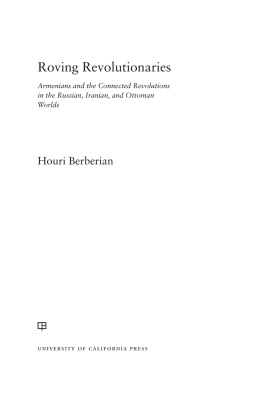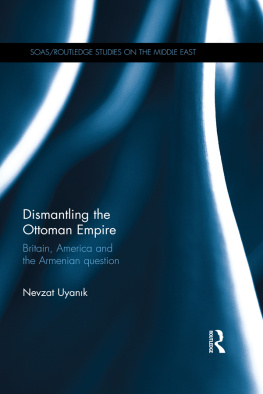IMPERIALISM, EVANGELISM AND THE OTTOMAN ARMENIANS, 18781896
Imperialism, Evangelism and the Ottoman Armenians 18781896
JEREMY SALT
Bilkent University
First published in 1993 by
FRANK CASS & CO. LTD.
Published 2013 by Routledge
2 Park Square, Milton Park, Abingdon, Oxon OX14 4RN
711 Third Avenue, New York, NY, 10017, USA
Routledge is an imprint of the Taylor & Francis Group, an informa business
Copyright 1993 Jeremy salt
British Library Cataloguing in Publication Data
Salt, Jeremy
Imperialism, evangelism and the Ottoman Armenians, 187896.
I. Title
956.62
Library of Congress Cataloging-in-Publication Data
Salt, Jeremy.
Imperialism, evangelism and the Ottoman Armenians, 187896 / Jeremy Salt.
p. cm.
Includes bibliographical references and index.
1. Armenian question. 2. TurkeyHistory18781909. 3. EuropeRelationsTurkey. 4. TurkeyRelationsEurope. 5. TurkeyRelationsUnited States. 6. United StatesRelationsTurkey.
I. Title.
DS194.S25 1992
956.62015dc20
91-18938
CIP
ISBN 13: 978-0-714-63448-7 (hbk)
All rights reserved. No part of this publication may be reproduced in any form or by any means, electronic, mechanical, photocopying, recording or otherwise, without the prior permission of the publisher.
To my mother, Mary Salt, and to the memory of my grandmother, Agnes Erby (18841984)
Contents
.
I would like to thank a number of people who have helped me in various ways at different stages of this project; Emeritus Professor John Bowman, of the Department of Middle Eastern Studies, Melbourne University; Patrick Singleton, formerly of the Baillieu Library at Melbourne University; Professor Ersin Kalayciolu of Boazii University, Istanbul; Professor Metin Heper, chairman of the Department of Politics and Public Administration, Bilkent University, Ankara; and Dr Nur Bilge Criss, of the Department of International Relations, Bilkent University. Material from this manuscript has been used as the basis for three articles. Ottoman Christians and Foreign Missionaries: A Precarious Symbiosis appeared in the International Journal of Turkish Studies, Vol. 3, No. 2 (Winter 1985/86). Nineteenth-Century Images of the Turks was published in Dr Rahmi Akelik (ed.), Before and After Gallipoli: A Collection of Australian and Turkish Writings (Melbourne, 1986). Britain, the Armenian Question and the Cause of Ottoman Reform 189496 appeared in Middle Eastern Studies, Vol. 26, No. 3 (July, 1990). I would like to thank Dr Akelik, together with Professor Kemal Karpat and the late Professor Elie Kedourie, for their permission to make use of this material again. The three cartoons are reproduced by courtesy of Punch, now sadly defunct.
Finally I must record my lasting gratitude to the late Anna Stewart, my wife, for all the support and encouragement she gave me in the early stages of this project.
Jeremy Salt
Ankara, 1992
The reader will not get far before discovering that this book is not a general history of the Armenians in the nineteenth or any other century. It is not intended to be. Certainly it is about the Armenians but it is also about the diplomats, missionaries and politicians whose interests and involvement helped to create the Armenian question in the last quarter of the nineteenth century. It is also about public opinion, and particularly the religious and racial biases that were usually carried into any discussion of Ottoman affairs. Although I hope the specialist will find some value in this work, I have written it with one eye on a more general audience. I believe that anyone interested in history could not fail to find the subject matter compelling, particularly as so much has been written about the tragic fate of the Armenians during the First World War but very little about this earlier period of their history.
Unfortunately, the period I have studied remains extremely controversial. As a neophyte I did not realise this when I began, and had I been aware of the ferocity still generated by debate on the Armenian question I might have been tempted to abandon the project altogether. Earlier drafts of the manuscript were submitted to other publishers, none of whom was able to find two readers who could agree on its worth, and their views were usually so divergent as totally to negate each other. Armenian or pro-Armenian readers accused me of glossing over the facts, of supporting Ottoman imperialism, of bandying around half-truths, of racism and even of Turkish linguistic chauvinism (had this particular reader known it, my knowledge of Turkish is very slight). From the other side came more constructive criticism and sometimes praise. Although anxious to see the work in print, I could not help feeling some sympathy for publishers expected to make a sound judgement on the basis of such expert but contradictory opinions, but perhaps this is a normal situation in the publishing world. In any case, the reaction should not have been surprising. Virtually the whole of that area of scholarship known as Modern Middle Eastern studies is a minefield and the Armenian question is no exception.
The facts as established in the joint report of the three foreign consuls observing the proceedings of the Ottoman Commission of Inquiry sitting at Mu (Shipley of Britain, Vilbert of France and Prjevalsky of Russia) were that 265 Armenian Christians were killed in the Sasun district, where troops had been sent to crush an uprising instigated by Hunchak revolutionaries. In a separate memorandum issued some time later, Consul Shipley put the number of Armenian dead at 900. It should surely be possible to accept this as a reasonably impartial outside estimate, yet, as we have seen, recent studies still insist on thousands of dead and seem reluctant to consider the much lower figure given in the joint report of the foreign consuls at all.
Thus, Christopher Walker can still refer to estimates of those killed at Sasun as varying between a very conservative 900 (as we have seen, the conservative estimate was actually 265) and 3000. Now it was hardly remarkable that the Kurdish hamidiye regiments were armed; there is not much point, after all, in maintaining unarmed military formations. There is no doubt that the sultan ordered his military commanders to uproot Armenian revolutionary cells and to suppress the numerous uprisings that the revolutionaries organised. Nor is there any doubt that in the conflict with Ottoman soldiers (regular and irregular) many Armenians were killed, the innocent as well as the guilty. There is evidence of massacre, but there is no evidence that the sultan ordered indiscriminate Kurdish attacks on peaceful Armenian villagers, as the sentence I have quoted insinuates. To transform the entire sequence of events into a plot engineered by the sultan to get rid of the Armenians once and for all appears to me to be a travesty of history. In an early chapter I study the religious and racial stereotypes that lent credibility to the most outrageous accusations made against the Turks, as Turks and as Muslims.
Nowhere do I deny the sufferings of the Armenians. Although I might challenge the figures, the scale of violence that swept the eastern provinces was truly horrific. The Armenians were undeniably the chief victims. As far as their general background is concerned I believe that although the view of the Armenians as a persecuted minority, victims of Mohammedan misrule and the demonic machinations of the sultan, was compelling in Victorian England, it was a distortion of the true picture. There is abundant evidence that on balance the position of Ottoman Christians was no worse than that of Ottoman Muslims. By and large the numerous failings of the system were borne by all and where the Armenians had specific complaints they were more than counterbalanced by the specific burdens of the Muslim majority. I produce evidence in support of this view.







